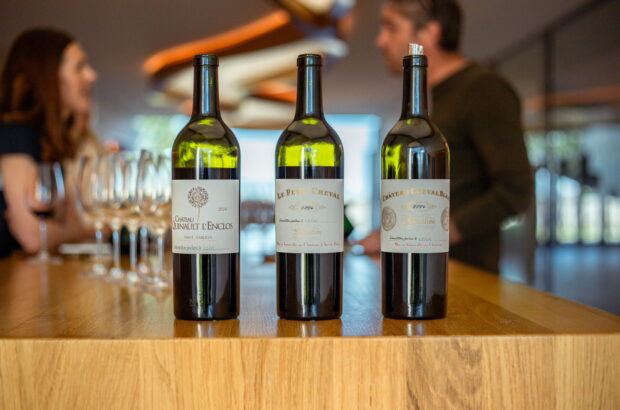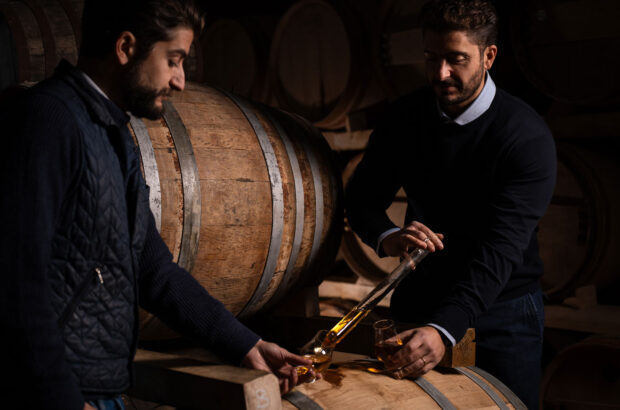Pink gin has become a favourite for many gin enthusiasts, offering an exciting twist on the traditional spirit. For some, it’s a serious alternative to regular gin, offering refreshing and fruity options that feel lighter and more summery.
Others simply love the striking pink hue of the bottles and the appeal of mixing a delicate, rosy Gin & Tonic on a sunny day. Then there are the purists who argue that pink gin strays too far from the classic gin formula. So, what’s the deal with pink gin, and how does it taste?
What is pink gin?

Pink Gin & Tonic Credit: Olexander Prokopenko / Alamy Stock Photo
The term ‘pink gin’ originally referred to a specific cocktail rather than a distinct type of gin. The cocktail itself is a simple but intriguing combination of Plymouth Gin and Angostura Bitters.
The drink’s creation dates back to the 19th century, with its origins commonly attributed to Henry Workshop, a ship’s surgeon in the British Royal Navy. In 1826, Workshop was stationed on the HMS Hercules in the Caribbean, where he first encountered Angostura Bitters while patrolling for slave trade vessels.
Angostura Bitters were invented in 1824 by Johann Gottlieb Benjamin Siegert, a German doctor working at a military hospital in Angostura, Venezuela. Originally designed as a medicinal treatment for upset stomachs and indigestion, these bitters gained popularity among sailors who used them to alleviate seasickness.
Workshop’s brilliant idea was to combine these bitters with Plymouth Gin, a popular naval ration, and the result was a striking pink-hued drink that became known as pink gin. By the mid-1800s, the cocktail had spread throughout England, becoming a staple of social gatherings.
If you’d like to recreate this classic drink at home, mix 5-6 dashes of Angostura Bitters with 60ml of gin in a glass filled with ice. Stir the mixture well to chill and dilute it slightly, then strain it into a chilled Martini glass and garnish with a lemon twist.
How does pink gin taste?

Pink gin is made with a range of different botanicals Credit: VICUSCHKA/Getty Images
Today, pink gin refers to a more modern style of gin that has been infused with a variety of botanicals. The most common infusions include fruits such as strawberries, raspberries and rhubarb, along with florals like rose petals. These botanicals give the gin a distinct taste and, of course, a beautiful rosy tint.
The flavour of pink gin can vary significantly depending on the botanicals used and the distillation methods. Some pink gins are very fruity, with bold notes of berries or citrus fruits such as pink grapefruit. Others are more delicate and floral, featuring hints of rose or elderflower. In contrast to the traditional, herbal gin experience, pink gin offers a lighter, more fragrant profile that many drinkers find refreshing.
What sets pink gin apart from regular gin is the additional botanicals, which impart a variety of flavours and make it a versatile drink for different tastes. For example, a fruity pink gin might feature the tang of strawberries or raspberries, while a more floral variety could have subtle rose or lavender undertones.
The best pink gins maintain a dry, juniper-forward flavour, which is crucial for keeping the balance between the traditional gin character and the additional fruity or floral notes. When paired with tonic water, this dry juniper base provides the familiar gin kick, while the added botanicals bring extra complexity to the overall taste.
What’s the best way to drink pink gin?

The beauty of pink gin is its versatility. While many people enjoy a classic pink Gin & Tonic, garnished with fresh fruit like strawberries or raspberries, others prefer to incorporate it into cocktails for added depth of flavour. It’s a popular drink for summer gatherings, offering a refreshing alternative to the usual gin cocktails, and its distinctive colour makes it perfect for special occasions, like Valentine’s Day.
Whether you prefer a more fruit-forward gin or one with a floral twist, there are numerous ways to enjoy pink gin. For a light, fruity G&T, mix pink gin with tonic and a handful of fresh berries for a delightful afternoon drink. If you’re feeling adventurous, you can use it in a variety of cocktails, from a pink gin fizz to a fruity twist on the classic Gin Martini.
Pink gin offers a fresh take on the traditional gin experience, with a variety of flavours to explore, from fruity berry notes to delicate floral hints. Whether you’re a gin purist or someone who enjoys a more modern twist on the classic spirit, there’s a pink gin out there for you. For those who appreciate both the aesthetic appeal and the taste of a drink, pink gin offers an ideal balance of tradition and innovation. So, go ahead and experiment with different mixers and garnishes – you might just find your new favourite gin!
Best pink gins: 12 to try
Amalthea Pink Gin
This distinctive gin is distilled in small batches at Fortnum & Mason’s famous department store on London’s Piccadilly. Amalthea is the name of the copper still in the third-floor distillery. Made from a base of apple spirit, botanicals include rhubarb, rose petals, grapefruit peel, cardamom seeds, hibiscus flowers and Fortnum’s Earl Grey Classic Tea. I love the aromas here: pretty rhubarb and rose tones, with a sprinkle of white pepper. On the palate exotic notes of cardamom spice balance Turkish Delight sweetness. A classic London Dry style, with a very spicy finish, plus crisp citrus – packs quite a punch! Try it in a Negroni. Alcohol 43%
Chapel Down Pinot Noir Gin
The perfect pink gin for wine lovers, this is distilled by English wine producer Chapel Down, which also makes a Chardonnay vodka. Made from distilled Pinot Noir grape skins and English wheat spirit, it’s infused with botanicals including coriander and rosehip. The pale pink hue comes from dried raspberries and strawberries. You’ll taste those berries on the deliciously creamy palate, along with clean citrus and plenty of juniper. Try it in a Tenterden Blush sparkling cocktail: 50ml of gin mixed with 50ml lemonade and topped with 25ml of Chapel Down Brut. Alc 41.2%
Chase Pink Grapefruit and Pomelo
Best known for its potato vodka and ‘field to bottle’ approach, Herefordshire farmers-turned-distillers Chase also make this zesty pink gin, which is distilled with pink grapefruit and pomelo peels. Packed with bold citrus aromas and flavours, it’s a zinger of a gin that delivers a sharp hit of grapefruit guaranteed to wake up your tastebuds. Pair with Fentimans Connoisseurs Tonic Water and garnish with a slice of pink grapefruit. Alc 40%
Elsker Dry Pink Gin
‘Elsker’ is the Norwegian word for ‘love’, so this bottle is an ideal choice for Valentine’s Day… It’s made by Stig Bareksten at the Oss Craft Distillery in Norway, whose drinks are inspired by the untamed Norwegian landscape. His pink gin includes wild raspberries and blueberries to create a rosy hue. There’s super balance here, with a natural tartness and sweetness from the fruit on the creamy palate. Notes of raspberry, rhubarb and cherry combine with juniper bite and dry spice for a fresh finish. Try it in a G&T. Alc 40%
Henley Gin, Rhubarb & Orange
A newcomer to the UK’s distilling scene, Henley Distillery took up residence in a restored threshing barn just outside Henley-on-Thames in 2021. Head distiller is Jacob Wilson, one of the youngest Master Distillers in the country, who produces a range of three small-batch Henley Gins: Classic Dry, Oriental Spiced and this pink Rhubarb & Orange. Pale onion-skin in colour, it has been layered with fresh orange zest and tart rhubarb to create a zesty, fruity, fresh and elegant gin. Notes of rhubarb and orange (as you’d expect) are joined by aromas of raspberry, fresh blackcurrant and Parma violet that carry through to the palate, where they join with a satisfying juniper hit and spice notes. An assured debut. Alc 42%
Kyrö Pink Gin
Finland’s Kyrö distillery makes this distinctive coppery onion-skin coloured gin, using a base of rye spirit. That rye gives an interesting savoury, grainy note to the aromas and adds real depth and a creamy silkiness to the palate. Infused with fresh red berries, rhubarb and foraged Finnish lingonberries, there are also the red fruit notes you’d expect from a pink gin, alongside herbs, spices and vanilla hints. Savour it in a Martini. Alc 38.2%
Mermaid Pink Gin
Queen Victoria liked to spend summers on the Isle of Wight and this eye-catching gin from the island’s distillery captures the spirit of a sunny seaside holiday. The signature Mermaid Gin is made with 10 ethically sourced botanicals including rock samphire, known locally as mermaid’s kiss. To make Mermaid Pink the team steep fresh island strawberries in gin for four days, then redistill. The result is a gin that’s laced with fresh strawberry notes, along with a salty ozone freshness – like eating strawberries and cream on the beach. Makes a fruity, fresh and creamy G&T. Alc 42%
Mirabeau Rosé Gin
The team behind Mirabeau rosé wines make this elegant pink gin that’s inspired by, and infused with, the grapes and botanicals growing wild on their Provence estate. A base of grape spirit extracted from Mirabeau’s Forever Summer wine is combined with 12 botanicals including juniper, coriander seed, lemon peel, lavender, jasmine, bay leaf, thyme, rosemary, iris root and angelica. They give an enveloping and fragrant florality on the nose, while the palate is lifted by citrus freshness and given an earthy touch by generous herbaceousness. There’s also an underlying soft sweetness from the addition of Mirabeau’s Provence rosé to the distillation. Refreshing and enjoyable to sip on its own, although a lemon peel garnish combined with a bitter tonic, or grapefruit juice, works well to amplify the herbal and floral characters while accenting the sweetness. Alc 43%
Salcombe Gin Rosé Sainte Marie
Devon’s Salcombe Distilling Co makes a range of excellent gins – including alcohol-free options – and its pink offering is no exception. Inspired by the South of France (Sainte Marie is a lighthouse in the old port of Marseille) it’s pale Provençal rosé pink in colour, with a floral, herbaceous nose: thyme and orange blossom hints plus red berry fruit. The silky and sophisticated palate has appealing notes of rose, plus a decent hit of juniper and a fresh herbaceous finish. Pair with Fever-Tree Mediterranean Tonic for a summery, floral Gin & Tonic. Alc 41.4%
Silent Pool English Rose Gin
One for fans of floral gins, this heady gin reminds me of walking through a rose garden, but avoids being cloying thanks to its freshness and bone dry palate. As the name suggests, Surrey distillers Silent Pool infuse their gin with English rose petals, which creates really pretty aromatics of freshly picked roses, with a hint of violet too. The elegant palate flourishes with notes of rosewater and Turkish delight, followed by a crisp citrus finish. Simply one of the best rose gins out there. Mix it with Fever-Tree Elderflower Tonic for a full-on flower-power G&T. Alc 42%
That Boutique-y Gin Company Proper Pink Gin
The clever chaps at That Boutique-y have put their own spin on pink gin, with this Proper version that blows a raspberry to, well, raspberries. Starting from the original Pink Gin cocktail recipe of gin plus Angostura Bitters, they first vacuum-distilled the Angostura to remove the colour and bitterness – but not the flavour – the re-bittered with a gentian tincture and added lemon distillate, finishing with a dash of Angostura Bitters added at the end. The result is a very elegant gin that’s fresh, grassy and citrussy (lemon and pink grapefruit), with liquorice and black pepper spice, plus chalky mineral streak. Really clean and crisp, it’s fabulous for a Martini – or try the recommended long serve with tonic and an orange twist. Alc 46%
The Bitter Truth Pink Gin
German company The Bitter Truth produces an excellent range of bitters for use in cocktails (Cherry and Olive are two of my particular favourites). So it’s no surprise that their pink gin sticks to the classic formula of gin + bitters. There’s even a sailing ship on the label to emphasise the naval origins. It’s made by blending the company’s own Aromatic Bitters with a London Dry gin, resulting in a fragrant spirit with aromas of Mediterranean herbs, oranges, lemons and of course, juniper freshness. There’s a herbal character on the creamy palate too, plus notes of spicy dried orange peel, fennel and caraway seeds. It’s equally good for a G&T or any Martini-style cocktails. Alc 40%







